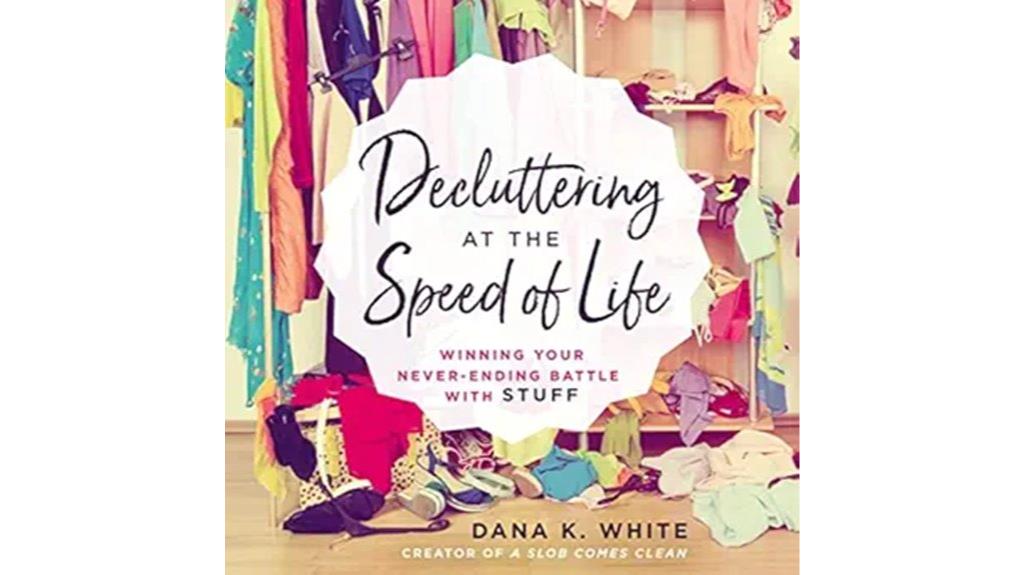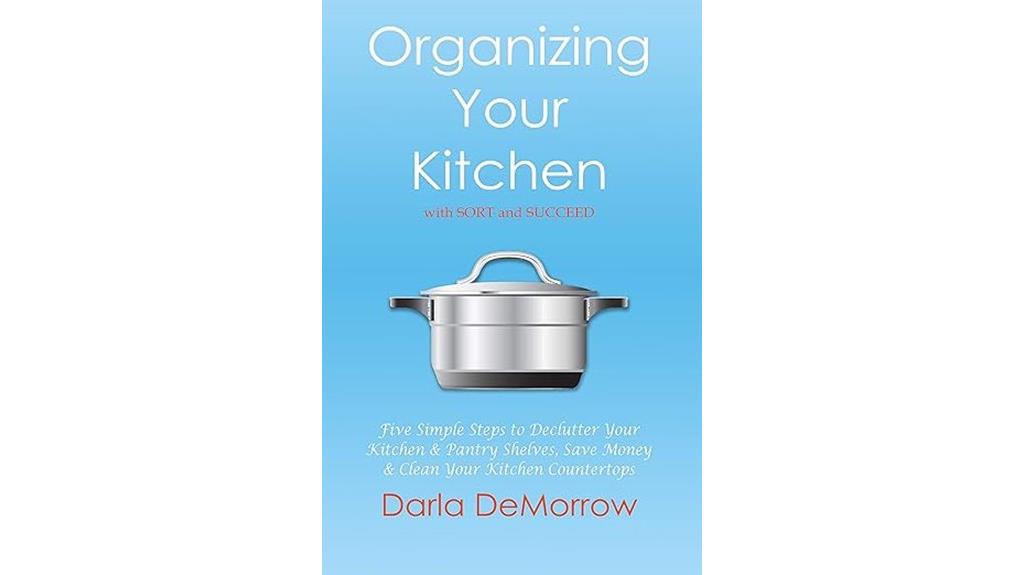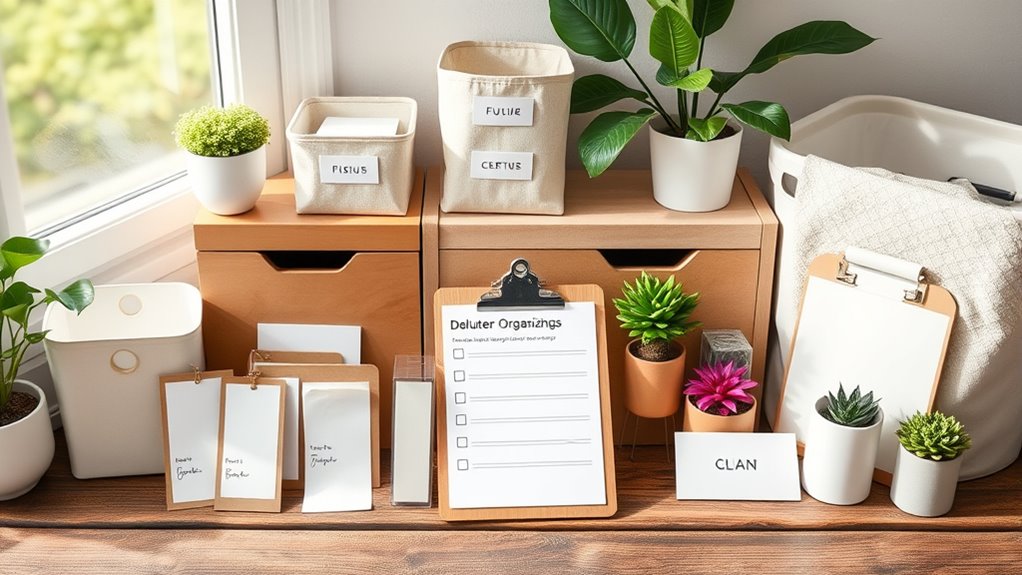If you're looking to kickstart your decluttering journey, I've found three awesome starter packs. First, "Decluttering at the Speed of Life" offers practical strategies tailored to your pace. Next, "Making Space, Clutter Free" helps you understand and tackle emotional attachments to your items. Finally, "SORT and Succeed" focuses on efficient kitchen organization with sustainable systems. Each pack addresses unique decluttering challenges, making it easier to choose what fits your needs best. Stick around to explore more insights!
Key Takeaways
- Look for starter packs under $30 that provide practical strategies and emotional support for effective decluttering.
- Choose resources that focus on specific areas like kitchens, bedrooms, or home offices to streamline your organization process.
- Evaluate packs that offer actionable steps and quick wins to maintain motivation throughout your decluttering journey.
- Select options that include community support components for additional guidance and encouragement during the organization process.
- Ensure the chosen starter packs fit your schedule, allowing for short, manageable sessions to effectively tackle clutter without feeling overwhelmed.
Decluttering at the Speed of Life

If you're someone who's overwhelmed by clutter but craves a straightforward approach to reclaiming your space, "Decluttering at the Speed of Life" is perfect for you. Dana K. White's relatable writing style and personal journey make this book enjoyable and accessible. She offers practical, actionable strategies that let you tackle clutter in small, manageable steps. I love how she encourages celebrating visible progress without the pressure of time constraints. The book's structure guides you through different areas of your home while acknowledging the emotional side of decluttering, making the process feel less intimidating and more achievable.
Best For: Individuals feeling overwhelmed by clutter who seek a practical and relatable approach to decluttering their spaces.
Pros:
- Offers practical, actionable strategies that facilitate decluttering in small, manageable steps.
- Acknowledges the emotional aspects of decluttering, providing a compassionate framework for decision-making.
- Lighthearted and engaging writing style makes the process enjoyable and relatable.
Cons:
- Some readers may find the focus on practical strategies lacking in deeper discussions about consumerism and emotional clutter.
- The approach may not suit those looking for a more intensive or comprehensive decluttering method.
- Certain readers may desire more structured timelines or rigid guidelines for decluttering progress.
Making Space, Clutter Free: The Last Book on Decluttering Youll Ever Need

For anyone struggling with the emotional weight of clutter, "Making Space, Clutter Free: The Last Book on Decluttering You'll Ever Need" is the perfect guide. It dives deep into why we cling to items, uncovering emotional triggers that resonate with my own experiences. The author's practical strategies make decluttering feel manageable, allowing me to tackle my clutter systematically. Plus, the interactive nature of the book inspires me to connect with others on social media, boosting my motivation. This book not only clarifies the emotional aspects of clutter but also offers valuable insights into its broader impacts, making it a must-read for anyone.
Best For: Individuals struggling with clutter who seek emotional understanding and practical strategies for decluttering their spaces.
Pros:
- Offers a deep exploration of emotional triggers related to clutter, helping readers understand their attachment to items.
- Provides practical and systematic strategies for decluttering, making the process feel achievable.
- Engages readers through social media interaction, enhancing motivation and community support.
Cons:
- Some readers may find the emotional introspection challenging or uncomfortable.
- The practical advice may feel overwhelming for those with significant clutter or complex situations.
- The book's interactive components might not resonate with everyone, potentially limiting its appeal.
SORT and Succeed: Organizing Your Kitchen

Organizing your kitchen becomes a breeze with "SORT and Succeed," especially for those feeling overwhelmed by clutter. This book offers straightforward tips that helped me create a cleaner, more functional space. I loved how accessible the writing is; it's easy to read and reference. With practical strategies like eliminating unnecessary storage or "storing air," I saw my kitchen transform—I'm now 75% organized! The focus on sustainable systems rather than quick fixes made a huge difference. Plus, I found motivation in the author's encouragement. This approach not only organized my kitchen but also brought peace to my home.
Best For: Individuals seeking practical and sustainable solutions to declutter and organize their kitchens for improved functionality and peace of mind.
Pros:
- Provides straightforward and easy-to-understand organizing tips that are accessible to a wide range of readers.
- Encourages sustainable systems that promote lasting organization rather than temporary fixes.
- Offers motivation and encouragement, helping readers feel a sense of progress in their organizing journey.
Cons:
- Focused primarily on kitchen organization, which may limit its appeal for those looking to declutter other areas of the home.
- Some readers may find certain strategies challenging to implement without additional guidance.
- The humor in phrases like "storing air" may not resonate with everyone and could be seen as trivial.
Factors to Consider When Choosing a Decluttering Starter Pack

When picking a decluttering starter pack, I always think about my personal motivation and goals. It's essential to take into account my emotional attachment to items and how practical the strategies are for my space. Also, I need to factor in the time I can realistically commit to the process.
Personal Motivation and Goals
Motivation plays a pivotal role in the decluttering journey, influencing your commitment to the process. I've found that understanding my personal motivation helps me stay focused. Identifying specific goals, like clearing clutter in high-traffic areas or creating an efficient workspace, gives clear direction. Setting achievable milestones keeps me motivated; celebrating those small wins reinforces my commitment. Reflecting on why I want to declutter—whether it's for a peaceful environment or better mental clarity—fuels my determination. I also acknowledge past struggles with clutter and use them as catalysts for change. This mindset empowers me to take actionable steps toward a more organized space. Remember, your motivation will guide you through the decluttering process, so embrace it!
Emotional Attachment to Items
While it's easy to get caught up in the thrill of decluttering, emotional attachments to items can complicate the process. I've found that these connections often stem from memories or feelings tied to certain objects, making it tough to let go. Sometimes, I hold onto things out of guilt, worrying about wasting money or resources. I've realized that emotional clutter can create significant barriers, as I feel like I'm losing a part of my identity when I consider discarding items. Understanding why I'm attached helps me make informed choices about what to keep. By reflecting on an item's true value and its relevance to my current life, I can approach decluttering with a clearer mindset and less emotional baggage.
Practicality of Strategies
Choosing the right decluttering starter pack can make all the difference in successfully transforming your space. When I look for a pack, I focus on strategies that emphasize small, manageable steps. This way, I don't feel overwhelmed and can maintain steady progress. I also appreciate approaches that highlight visible achievements and celebrate small wins, as they keep me motivated. It's essential for me that the strategies offer practical advice that fits various life situations, like downsizing or sorting inherited items. I prefer resources that tackle emotional blocks, helping me understand why I hold onto certain items. Finally, I want a system that promotes sustainable organization rather than quick fixes, ensuring my space stays clutter-free in the long run.
Room-Specific Needs
When it comes to decluttering, understanding the unique needs of each room is vital. Each space presents specific challenges that require tailored strategies. For instance, the kitchen demands organization for food storage and cooking tools, while the living room focuses on managing entertainment items and personal belongings. I've noticed that emotional attachments can complicate decluttering; bedrooms often hold sentimental items, whereas bathrooms may hide expired products contributing to clutter. Evaluating functional requirements helps too—creating clear pathways in high-traffic areas is essential. Prioritizing items based on room type, like tackling paper clutter in home offices or clothing in bedrooms, can streamline the process. Ultimately, adapting your approach to each room's needs makes decluttering more effective and manageable.
Time Commitment Required
Understanding how much time you can realistically commit to decluttering is essential for success. I've found that some methods emphasize small, manageable sessions, while others demand longer, intensive efforts. It's vital to choose resources that adapt to your schedule, helping you make progress at your pace without feeling overwhelmed. I often start with short bursts of activity—like dedicating 15 to 30 minutes each day to sorting and organizing. Assess your availability and consider strategies that focus on one room or category at a time, making the process less intimidating. I also recommend tackling areas that look the messiest first. These quick wins can provide immediate satisfaction and motivate you to keep going, even within limited timeframes.
Budget Considerations
Budget plays an essential role in selecting the right decluttering starter pack for your needs. I recommend setting a specific budget range to help narrow down your options and avoid impulse purchases that could disrupt your financial goals. Thankfully, many effective decluttering resources are available at various price points, often under $30. This makes it easier to find practical strategies and emotional support without breaking the bank. Look for starter packs that offer real value without high upfront costs; sometimes, the most effective solutions aren't the most expensive. Also, remember to factor in any potential costs associated with disposal or storage of items you're decluttering, as these can impact your overall budget if overlooked.
Frequently Asked Questions
What Are the Benefits of Decluttering for Mental Health?
Decluttering has profoundly improved my mental health. I've noticed that clearing my space reduces stress and anxiety, making it easier to focus and think clearly. It's like a refreshing change; I feel lighter and more in control of my environment. Plus, the act of organizing gives me a sense of accomplishment. When I create a tidy space, I'm not just tidying up; I'm nurturing my mind and boosting my overall well-being.
How Often Should I Declutter My Home?
I believe I should declutter my home at least seasonally, but it really depends on my lifestyle and how clutter builds up. I find that doing it every few months keeps my space feeling fresh and organized. When I notice items piling up or I feel overwhelmed, I tackle it right away. Regularly checking in on my belongings helps me maintain a calm, clutter-free environment that feels inviting and peaceful.
Can Decluttering Improve Productivity?
Imagine a clear desk, an organized closet, and a serene living room. I've found that decluttering does boost productivity. When I remove distractions, I can focus better on tasks at hand. A tidy space creates a calm mind, allowing me to think clearly and work efficiently. Plus, I waste less time searching for things. So yes, decluttering not only refreshes my environment but also elevates my productivity to new heights!
What Items Should I Avoid Decluttering?
When I think about what items to avoid decluttering, I focus on sentimental items and essentials. I've learned not to rush into getting rid of things that hold memories or that I use regularly. Those family heirlooms or gifts from friends mean a lot to me, and I can't replace them easily. I also keep important documents and items that serve a practical purpose. It's all about finding that balance!
How Do I Maintain a Clutter-Free Space Long-Term?
To maintain a clutter-free space long-term, I prioritize daily habits. I've set aside just ten minutes each day for tidying up, and I always return items to their designated spots. I regularly assess my belongings, asking if I truly need each item. I also tackle larger decluttering sessions monthly to keep things in check. By creating a routine and sticking to it, I've found it much easier to enjoy a neat, organized environment.
Conclusion
As I stand at the edge of a vast, untamed forest—representing the clutter in our lives—I invite you to take the first step on your path to clarity. With the right decluttering starter pack, you'll wield a compass to navigate through the thickets of chaos, discovering hidden treasures along the way. Embrace this journey, and soon you'll find that the lightness of being clutter-free is just a few thoughtful choices away. Let's venture forth together!









